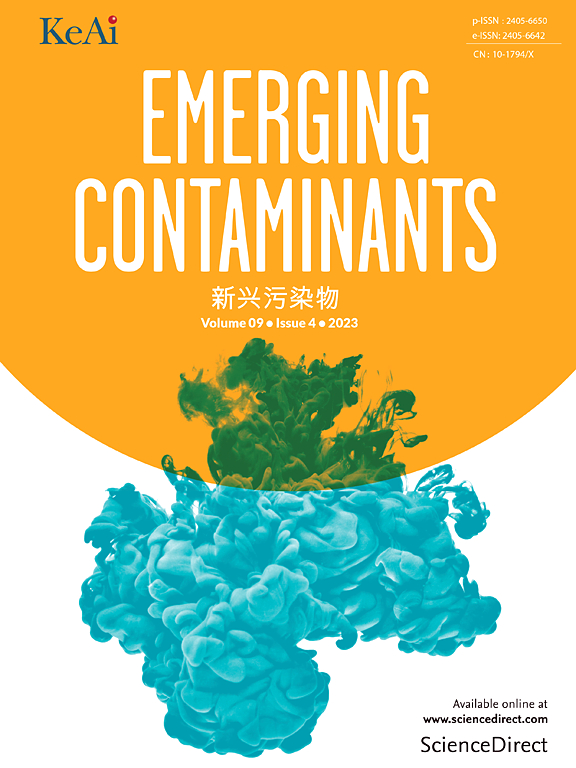母体双酚A暴露对甲状腺激素和出生人体测量结果的影响:一项重复测量研究
IF 6.9
2区 环境科学与生态学
Q1 ENVIRONMENTAL SCIENCES
引用次数: 0
摘要
我们研究了产前双酚A (BPA)暴露对母体甲状腺激素和胎儿生长结果的影响。在这项前瞻性研究中,672名孕妇提供了1957份尿液样本,在三个月期间使用UPLC-MS/MS分析了BPA浓度。我们记录了BPA的检出率和中位浓度,并使用混合效应模型来检测对母体甲状腺激素的影响,特别是游离甲状腺素(FT4)和促甲状腺激素(TSH)。此外,我们通过调整混杂因素的多变量回归探讨了对胎儿生长标志物(如头围(HC)和胎盘重量(PWT))的影响。研究结果表明,超过95%的样本中存在双酚a,从妊娠1至妊娠3个月的中位数浓度显著下降。高BPA暴露与FT4水平增加2.96%和TSH水平降低14.58%相关。胎儿生长分析显示,孕早期BPA水平高,HC和PWT分别下降3.8%和15.3%。此外,孕早期和妊娠中期的FT4水平介导BPA暴露与胎儿生长结果之间的关系,PWT为21.1%,HC为19.1%,而孕龄介导HC变化的12.1%。该研究强调了高BPA暴露对甲状腺功能的严重破坏和胎儿发育的有害影响,强调了在怀孕期间严格监测和预防措施的必要性。本文章由计算机程序翻译,如有差异,请以英文原文为准。

Impact of maternal Bisphenol A exposure on thyroid hormones and birth anthropometric outcomes: A repeated measures study
We investigated the effects of prenatal bisphenol A (BPA) exposure on maternal thyroid hormones and fetal growth outcomes within a cohort from Saudi Arabia. In this prospective study, 672 pregnant women provided 1957 urine samples, which were analyzed for BPA concentrations using UPLC-MS/MS throughout three trimesters. We recorded BPA detection rates and median concentrations, using mixed-effects models to examine the influence on maternal thyroid hormones, specifically free thyroxine (FT4) and thyroid-stimulating hormone (TSH). Additionally, we explored the impact on fetal growth markers such as head circumference (HC) and placental weight (PWT) through multivariable regression, adjusting for confounders. Findings indicated that BPA was present in over 95 % of samples, with a notable decrease in median concentrations from the 1st to the 3rd trimester. Higher BPA exposure correlated with a 2.96 % increase in FT4 levels and a 14.58 % reduction in TSH in the top exposure quartile. Fetal growth analysis showed a decrease of 3.8 % in HC and 15.3 % in PWT associated with high first-trimester BPA levels. Furthermore, FT4 levels in the first and 2nd trimesters mediated the relationship between BPA exposure and fetal growth outcomes by 21.1 % for PWT and 19.1 % for HC, while gestational age mediated 12.1 % of the change in HC. The study highlights significant disruptions in thyroid function and detrimental effects on fetal development due to high BPA exposure, underscoring the need for rigorous monitoring and preventive measures during pregnancy.
求助全文
通过发布文献求助,成功后即可免费获取论文全文。
去求助
来源期刊

Emerging Contaminants
Medicine-Public Health, Environmental and Occupational Health
CiteScore
10.00
自引率
6.70%
发文量
35
审稿时长
44 days
期刊介绍:
Emerging Contaminants is an outlet for world-leading research addressing problems associated with environmental contamination caused by emerging contaminants and their solutions. Emerging contaminants are defined as chemicals that are not currently (or have been only recently) regulated and about which there exist concerns regarding their impact on human or ecological health. Examples of emerging contaminants include disinfection by-products, pharmaceutical and personal care products, persistent organic chemicals, and mercury etc. as well as their degradation products. We encourage papers addressing science that facilitates greater understanding of the nature, extent, and impacts of the presence of emerging contaminants in the environment; technology that exploits original principles to reduce and control their environmental presence; as well as the development, implementation and efficacy of national and international policies to protect human health and the environment from emerging contaminants.
 求助内容:
求助内容: 应助结果提醒方式:
应助结果提醒方式:


